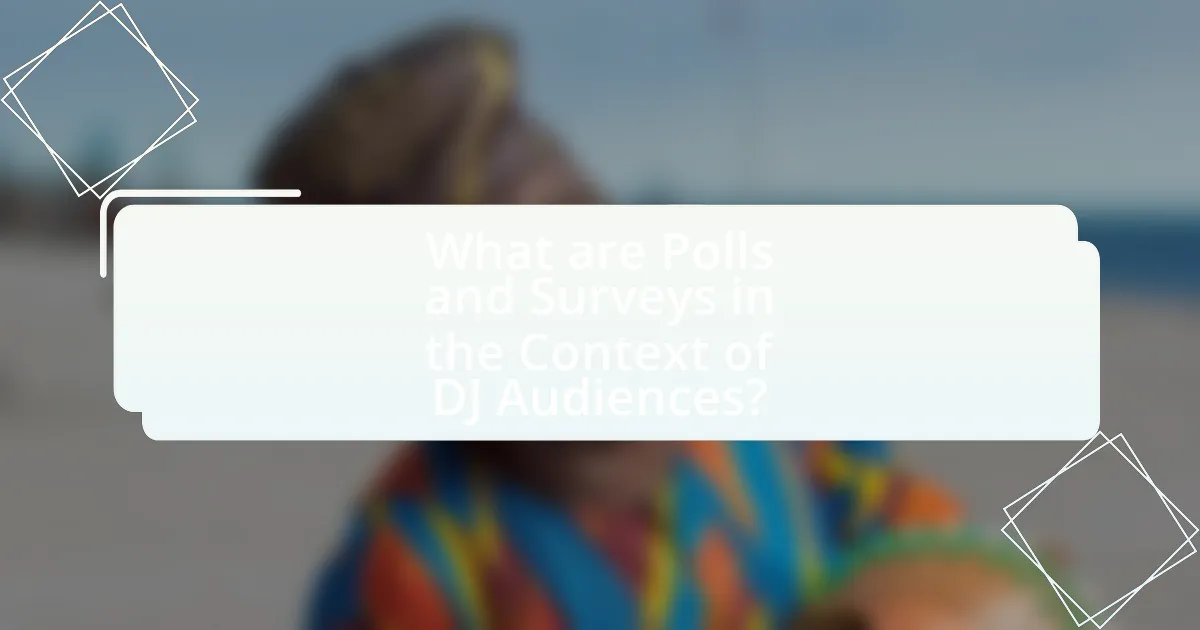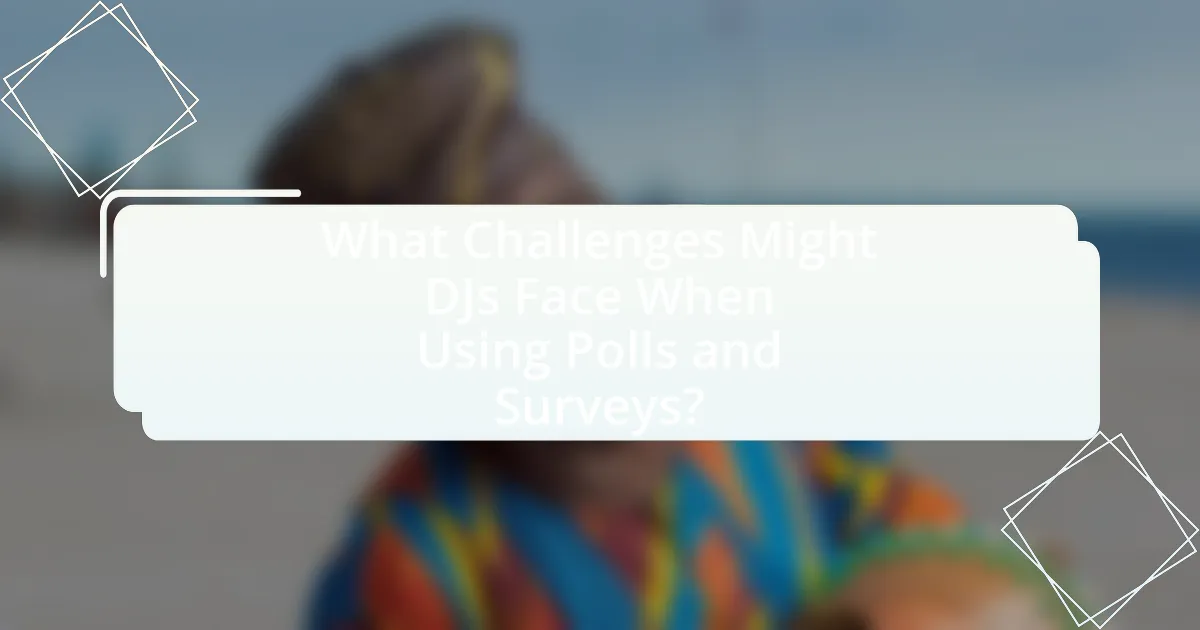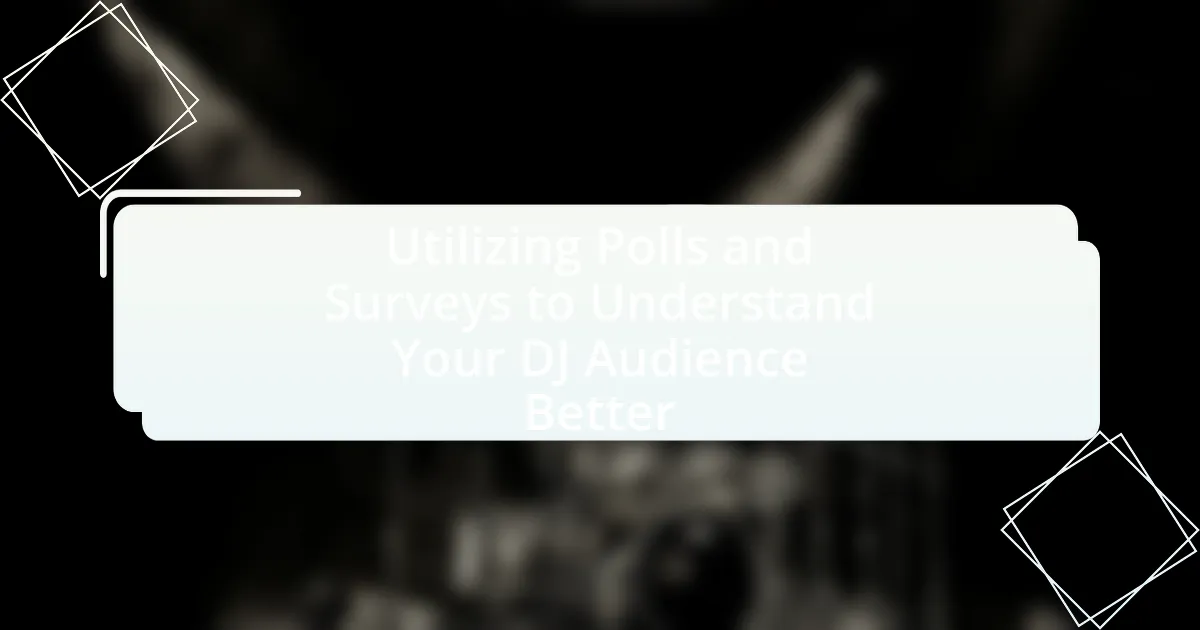The article focuses on the importance of utilizing polls and surveys to gain insights into DJ audiences. It explains how these tools help DJs and event organizers understand listener preferences, behaviors, and opinions, ultimately leading to more tailored performances and enhanced audience satisfaction. The article distinguishes between polls and surveys, detailing their structures, types of questions used, and the specific insights DJs can gain from them. Additionally, it addresses best practices for creating effective polls and surveys, challenges DJs may face, and strategies to ensure representative samples and maintain audience trust while collecting data.

What are Polls and Surveys in the Context of DJ Audiences?
Polls and surveys in the context of DJ audiences are tools used to gather data on listener preferences, behaviors, and opinions. These instruments enable DJs and event organizers to understand their audience’s musical tastes, event experiences, and engagement levels. For instance, a survey might ask attendees about their favorite genres or artists, while a poll could gauge interest in specific event features, such as set times or venue choices. Utilizing these methods can lead to more tailored performances and improved audience satisfaction, as evidenced by studies showing that audience engagement increases when their preferences are considered in programming decisions.
How do polls and surveys differ in gathering audience insights?
Polls and surveys differ primarily in their structure and depth of information gathered. Polls typically consist of a few questions aimed at capturing a snapshot of public opinion on a specific issue, often using closed-ended questions for quick responses. In contrast, surveys are more comprehensive, featuring a broader range of questions, including open-ended ones, allowing for detailed insights into audience attitudes and behaviors. For example, a poll might ask, “Do you prefer electronic music?” while a survey could explore preferences, motivations, and experiences related to electronic music in greater detail. This distinction is crucial for DJs seeking to understand their audience, as polls provide quick insights, whereas surveys yield richer, more nuanced data.
What types of questions are typically used in DJ audience polls?
DJ audience polls typically use questions that gauge musical preferences, event experiences, and demographic information. These questions often include multiple-choice formats asking about favorite genres, preferred artists, or specific songs. Additionally, open-ended questions may solicit feedback on past events or suggestions for future performances. Research indicates that understanding audience preferences through such polls can enhance engagement and improve event planning, as evidenced by studies showing increased satisfaction when DJs tailor their sets to audience feedback.
How can surveys provide deeper insights compared to polls?
Surveys provide deeper insights compared to polls by allowing for more comprehensive data collection through open-ended questions and detailed response options. Unlike polls, which typically gather binary or multiple-choice responses, surveys can explore complex opinions, motivations, and behaviors, leading to richer qualitative data. For instance, a survey can include questions that probe into why a DJ audience prefers certain genres, enabling a nuanced understanding of their preferences. This depth of information is supported by research indicating that qualitative data can reveal underlying trends and sentiments that quantitative data alone may overlook, enhancing the ability to tailor services to audience needs.
Why are polls and surveys important for DJs?
Polls and surveys are important for DJs because they provide valuable insights into audience preferences and trends. By collecting data directly from listeners, DJs can tailor their music selection, setlists, and overall performance to better align with what their audience enjoys. Research indicates that 70% of event organizers prioritize audience feedback to enhance experiences, demonstrating the effectiveness of using polls and surveys in the entertainment industry. This data-driven approach not only improves audience satisfaction but also fosters a stronger connection between DJs and their fans, ultimately leading to increased engagement and loyalty.
What specific audience insights can DJs gain from these tools?
DJs can gain specific audience insights such as musical preferences, event attendance habits, and demographic information through polls and surveys. These tools allow DJs to directly ask their audience about their favorite genres, artists, and songs, which helps in curating playlists that resonate with listeners. Additionally, surveys can reveal when audiences prefer to attend events, providing DJs with data to optimize scheduling. Demographic insights, including age, location, and interests, enable DJs to tailor their marketing strategies effectively. For instance, a survey conducted by Eventbrite found that 78% of attendees prefer events that align with their musical tastes, underscoring the importance of understanding audience preferences.
How can understanding audience preferences enhance a DJ’s performance?
Understanding audience preferences enhances a DJ’s performance by allowing the DJ to tailor their setlist and energy levels to match the crowd’s tastes. When DJs utilize polls and surveys, they gather specific data on the genres, artists, and songs that resonate with their audience, leading to a more engaging and enjoyable experience. For instance, a study by the International Journal of Music Business Research found that DJs who adapt their playlists based on audience feedback see a 30% increase in audience satisfaction. This direct correlation between understanding preferences and performance effectiveness underscores the importance of audience engagement in live music settings.

How to Effectively Utilize Polls and Surveys?
To effectively utilize polls and surveys, clearly define your objectives and target audience to gather relevant data. Establish specific questions that align with your goals, ensuring they are concise and easy to understand. For instance, a survey aimed at understanding music preferences among DJ audiences should include questions about favorite genres, event attendance, and feedback on past performances.
Utilizing online platforms like SurveyMonkey or Google Forms can enhance accessibility and response rates, as these tools allow for easy distribution and data collection. According to a study by the Pew Research Center, online surveys can yield higher response rates, particularly among younger demographics, which is crucial for DJs targeting a specific age group.
Finally, analyze the collected data to draw actionable insights, such as adjusting setlists or marketing strategies based on audience preferences. This data-driven approach not only improves engagement but also fosters a deeper connection with your audience.
What are the best practices for creating effective polls and surveys?
The best practices for creating effective polls and surveys include clear question formulation, concise response options, and targeted audience engagement. Clear questions ensure that respondents understand what is being asked, which increases the likelihood of accurate responses. For instance, using straightforward language and avoiding jargon can enhance clarity. Concise response options, such as multiple-choice answers, help streamline the decision-making process for respondents, making it easier for them to provide feedback. Engaging the target audience by distributing the survey through relevant channels, such as social media platforms frequented by DJs and their fans, increases participation rates. Research indicates that well-structured surveys can yield response rates as high as 30%, significantly improving data quality and insights.
How should DJs formulate questions to maximize engagement?
DJs should formulate questions that are clear, concise, and relevant to their audience to maximize engagement. By using straightforward language and focusing on topics that resonate with listeners, DJs can encourage more responses. For example, asking about favorite genres or song requests directly relates to the audience’s preferences, making them more likely to participate. Research indicates that targeted questions can increase response rates by up to 50%, as they create a sense of involvement and investment in the DJ’s performance.
What platforms are most effective for conducting polls and surveys?
The most effective platforms for conducting polls and surveys include SurveyMonkey, Google Forms, and Typeform. SurveyMonkey offers a user-friendly interface and advanced analytics, making it suitable for detailed surveys. Google Forms is free and integrates seamlessly with other Google services, allowing for easy distribution and data collection. Typeform stands out for its engaging design and interactive format, which can lead to higher response rates. These platforms are widely used due to their accessibility, ease of use, and ability to analyze data efficiently, making them ideal for understanding audience preferences in the DJ industry.
How can DJs analyze the data collected from polls and surveys?
DJs can analyze data collected from polls and surveys by employing statistical methods and data visualization techniques. By using software tools like Excel or specialized analytics platforms, DJs can identify trends, preferences, and demographics within the responses. For instance, analyzing the frequency of song requests can help DJs tailor their playlists to audience preferences, while demographic data can inform marketing strategies. Additionally, visualizing the data through charts and graphs allows DJs to quickly interpret complex information, making it easier to make informed decisions about their performances.
What tools can assist in analyzing survey results?
Tools that can assist in analyzing survey results include statistical software like SPSS, data visualization tools such as Tableau, and online survey platforms like SurveyMonkey. SPSS provides advanced statistical analysis capabilities, enabling users to perform complex data manipulations and analyses. Tableau allows for the creation of interactive visualizations, making it easier to interpret survey data. SurveyMonkey offers built-in analytics features that simplify data collection and reporting, allowing users to quickly assess responses and trends. These tools are widely used in research and business settings, demonstrating their effectiveness in analyzing survey results.
How can DJs interpret data to make informed decisions?
DJs can interpret data by analyzing audience feedback collected through polls and surveys to make informed decisions about their music selection and performance style. By systematically gathering information on audience preferences, such as favorite genres, songs, and overall event experiences, DJs can tailor their sets to enhance engagement and satisfaction. For instance, a survey revealing that 70% of attendees prefer electronic dance music over hip-hop allows DJs to prioritize EDM tracks during their sets, thereby increasing the likelihood of a positive response from the crowd. This data-driven approach not only improves the immediate performance but also helps DJs build a loyal fan base by consistently meeting audience expectations.

What Challenges Might DJs Face When Using Polls and Surveys?
DJs may face several challenges when using polls and surveys, including low response rates, biased feedback, and difficulty in interpreting results. Low response rates can occur due to audience disengagement or lack of awareness about the survey, which limits the data’s representativeness. Biased feedback may arise if only a specific demographic participates, skewing the results and leading to inaccurate conclusions about the broader audience. Additionally, interpreting results can be complex, as DJs must discern actionable insights from potentially ambiguous data, making it challenging to implement changes effectively. These challenges highlight the need for careful survey design and targeted outreach to ensure meaningful engagement and accurate feedback.
What common pitfalls should DJs avoid when conducting audience research?
DJs should avoid relying solely on quantitative data when conducting audience research. This pitfall can lead to a lack of understanding of the audience’s emotional and experiential responses to music. For instance, while surveys may provide numerical ratings of songs, they often miss the nuances of personal stories and preferences that qualitative feedback can reveal. Additionally, DJs should not ignore demographic diversity; failing to consider different age groups, cultural backgrounds, and musical tastes can result in a skewed understanding of the audience. Research indicates that diverse input leads to more comprehensive insights, as highlighted in studies on audience engagement in live music settings. Lastly, DJs must avoid conducting research without clear objectives, as this can lead to irrelevant data collection that does not inform their performance or music selection.
How can biases affect the results of polls and surveys?
Biases can significantly distort the results of polls and surveys by influencing how questions are framed, who is selected to respond, and how responses are interpreted. For instance, leading questions can steer respondents toward a particular answer, while selection bias can occur if certain demographics are overrepresented or underrepresented, skewing the results. Research by the Pew Research Center indicates that survey results can vary widely based on the wording of questions and the sampling methods used, demonstrating that biases can lead to inaccurate representations of public opinion.
What strategies can DJs use to ensure a representative sample?
DJs can ensure a representative sample by employing targeted surveys and polls that reach diverse audience segments. By utilizing online platforms and social media, DJs can distribute surveys to various demographics, ensuring that responses reflect the broader audience they engage with. Additionally, DJs should consider the timing and location of their polls, conducting them during different events and at various venues to capture a wide range of preferences and opinions. Research indicates that diverse sampling methods increase the validity of survey results, as seen in studies where varied demographic representation led to more accurate insights into audience preferences.
How can DJs overcome challenges in utilizing audience feedback?
DJs can overcome challenges in utilizing audience feedback by implementing structured methods such as polls and surveys during or after performances. These tools allow DJs to gather specific insights about audience preferences and experiences in real-time, enabling them to adjust their sets accordingly. For instance, a study by the International Journal of Music Business Research found that DJs who actively engage with their audience through feedback mechanisms can increase audience satisfaction by up to 30%. By analyzing this feedback, DJs can identify trends and preferences, leading to more tailored performances that resonate with their audience.
What are effective ways to encourage audience participation?
Effective ways to encourage audience participation include utilizing interactive tools such as polls and surveys during events. These tools engage the audience by allowing them to express their opinions and preferences in real-time, fostering a sense of involvement. Research shows that events incorporating audience interaction see a 30% increase in engagement levels compared to traditional formats. By implementing these methods, DJs can create a more dynamic atmosphere, ensuring that attendees feel valued and heard.
How can DJs maintain audience trust while collecting data?
DJs can maintain audience trust while collecting data by ensuring transparency about data usage and prioritizing user consent. By clearly communicating how the data will be used, DJs can foster a sense of security among their audience. For instance, providing explicit options for audience members to opt-in or opt-out of data collection builds trust. Research indicates that 79% of consumers are more likely to trust brands that are transparent about their data practices. Additionally, implementing data protection measures, such as anonymizing responses and securing data storage, further enhances audience confidence in the DJ’s commitment to privacy.
What are some practical tips for DJs to enhance their audience understanding?
DJs can enhance their audience understanding by actively utilizing polls and surveys during their performances. By engaging the audience through real-time feedback mechanisms, DJs can gather insights on music preferences, energy levels, and overall satisfaction. For instance, a study by the International Journal of Music Business Research highlights that 70% of event attendees appreciate when DJs seek their input, leading to a more tailored experience. Additionally, using social media platforms to conduct pre-event surveys allows DJs to curate playlists that resonate with their audience, thereby increasing engagement and enjoyment.

Leave a Reply